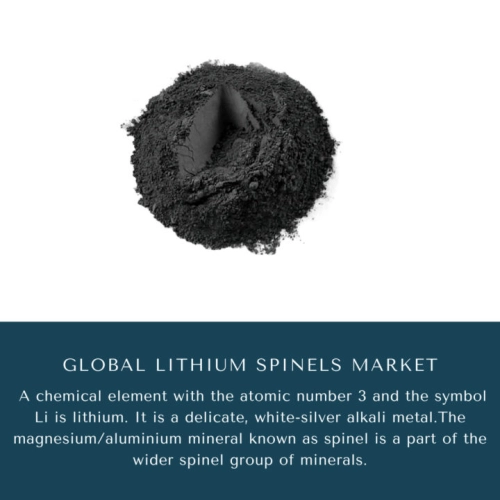
- Get in Touch with Us

Last Updated: Apr 26, 2025 | Study Period: 2024-2030
A chemical element with the atomic number 3 and the symbol Li is lithium. It is a delicate, white-silver alkali metal. The magnesium/aluminum mineral known as spinel is a part of the wider spinel group of minerals.
Spinel is an essential cathode material for lithium-ion batteries that has piqued the interest of both academics and industry.

Electronics, toys, wireless headphones, handheld power tools, small and big appliances, electric cars, and electrical energy storage systems are just a few of the devices that employ lithium-ion (Li-ion) batteries.
The Global Lithium Spinel's market accounted for $XX Billion in 2023 and is anticipated to reach $XX Billion by 2030, registering a CAGR of XX% from 2024 to 2030.
Developing high-voltage spinel LiNi0.5Mn1.5O4 cathodes for high-energy-density lithium-ion batteries: current achievements and future prospects High-voltage spinel LiNi0.5Mn1.5O4 (LNMO) is a promising cathode for the next-generation high-performance lithium-ion batteries (LIBs) because of its high energy density (650 W h kg1), high working voltage (4.7 V vs. Li), low manufacturing cost, and minimal environmental effect.
LNMO's limited commercialization and extensive application are, however, hampered by its short cycle life, which is brought on by cycling's quick capacity decay.
Intense research has been conducted to increase the electrochemical performance of LNMO, with only fair success. Therefore, a review and summary of the most recent discoveries and a greater comprehension of how to adjust LNMO are critically important.
The crystalline structure and electrochemical properties of LNMO spinel, as well as existing difficulties and relevant solutions, are thoroughly examined.
In addition, current achievements in LNMO application in full-cell designs are discussed. Finally, some insight into the future prospects for LNMO cathode development is presented.
| Sl no | Topic |
| 1 | Market Segmentation |
| 2 | Scope of the report |
| 3 | Abbreviations |
| 4 | Research Methodology |
| 5 | Executive Summary |
| 6 | Introduction |
| 7 | Insights from Industry stakeholders |
| 8 | Cost breakdown of Product by sub-components and average profit margin |
| 9 | Disruptive innovation in the Industry |
| 10 | Technology trends in the Industry |
| 11 | Consumer trends in the industry |
| 12 | Recent Production Milestones |
| 13 | Component Manufacturing in US, EU and China |
| 14 | COVID-19 impact on overall market |
| 15 | COVID-19 impact on Production of components |
| 16 | COVID-19 impact on Point of sale |
| 17 | Market Segmentation, Dynamics and Forecast by Geography, 2024-2030 |
| 18 | Market Segmentation, Dynamics and Forecast by Product Type, 2024-2030 |
| 19 | Market Segmentation, Dynamics and Forecast by Application, 2024-2030 |
| 20 | Market Segmentation, Dynamics and Forecast by End use, 2024-2030 |
| 21 | Product installation rate by OEM, 2023 |
| 22 | Incline/Decline in Average B-2-B selling price in past 5 years |
| 23 | Competition from substitute products |
| 24 | Gross margin and average profitability of suppliers |
| 25 | New product development in past 12 months |
| 26 | M&A in past 12 months |
| 27 | Growth strategy of leading players |
| 28 | Market share of vendors, 2023 |
| 29 | Company Profiles |
| 30 | Unmet needs and opportunity for new suppliers |
| 31 | Conclusion |
| 32 | Appendix |